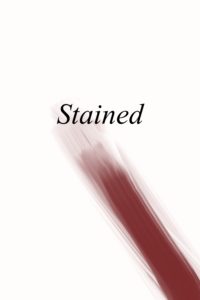 Stained: an anthology of writing about menstruation
Stained: an anthology of writing about menstruation
Curators/Editors Rachel Neve-Midbar and Jennifer Saunders
Review by Christine Stewart-Nuñez
Scholar Andrea Lunsford describes predominant rhetorical features of women’s writing—across centuries—as breaking silence and naming in personal terms. These two features resonated with me as I read Stained: an anthology of writing about menstruation, which offers poems, short stories, and personal essays of new writing by women, non-binary, and transgender men. To achieve taboo-shattering power, curators/editors Rachel Neve-Midbar and Jennifer Saunders braided pieces that explore menstruation’s presence and absence across various contexts. The inclusion of writing from diverse voices and experiences makes this an exceptional volume: I learned; I laughed; I cried.
My favorite pieces challenged me to re-see the ordinary, whether it be stained underwear or a tampon applicator. Katherine Hoerth’s “Paloma Wings,” for example, altered my perception of a sanitary napkin:
As a kid, I imagined a flock of them,
of maxi pads,
taking to the sky like startled palomas,
outstretching their white wings
and using them to get as far from me
as possible at that time of the month. (71)
Delightfully imaginative and poignantly real, Hoerth’s imagery expresses the emotional complexity periods can evoke. The ‘prep for your period’ narratives scattered throughout the book also point to that complexity. For decades, a Kotex box booklet or a school film framed menstruation for girls, leaving gaps of knowledge which typically increased fear and confusion when periods arrived. Many stories break the silences sparked by shame.
I also appreciated pieces that challenged my understanding of medical diagnoses related to reproductive biology, like Kellie Diodato’s “Stripping Away at My Allowance,” a truth-revealing poem about Polycystic Ovarian Syndrome. Others described uterine fibroids and endometriosis, strengthening my sense of their potential impact. Including narratives which recall the same procedure from different standpoints invited deeper thinking as well. For example, Virginia Chase Sutton’s “Blood” narrates moments of tension along the timeline toward an emergency hysterectomy, whereas Chris Talbot-Heindl celebrates their planned (and fought for) hysterectomy—still life saving but for different reasons.
Some pieces in Stained even helped me revise the value I attach to monthly bleeding. In “Red,” Nikki Marrone disassociates blood from its typical meaning: “Sometimes I leave the blood on my skin, / To remember that red is not the colour of violence. / And that I am not a victim waiting to happen” (92). The way she moved from image to meaning to a broader significance was stunning. Further, Nina B. Lichtenstein’s “When Your Flow is a Religious Affair: My Menstrual Cycle as an Orthodox Jewess” expanded my understanding of Jewish ritual and my respect for the sacred dimension of self-care.
Neve-Midbar and Saunders use color as an organization principle, inviting moments for reflection. And the juxtaposition of pieces with different textures heightened my anticipation and surprise. The short story, “The Stranger at My Underwear Drawer,” conveys thoughtful speculation about the future, whereas the poem that follows made me laugh. Raye Hendrix’s “Ode to My Menstrual Cup” reads:
you are holy: savior
of my underwear, protector
of my jeans, thanks to you
I do my laundry and the whites
are white as snow. (163)
Many pieces evoked multiple emotions. For instance, “Gift for a Grown-Up Girl,” Christina Myers’ narrative about an awkward father’s gift to his daughter to mark her first period, felt sweet among reverberations of fear, regret and exclusion.
Finally, I appreciated the writers who spoke back to stereotypes—some more subtle than others. For instance, Kelli Russell Agodon’s “What the Internet Told Me About Menopause” concludes with a comment on how some women are seen or not seen:
No one says I might not notice
when others stop
noticing, when I move from miss
to ma’am. I say, Sometimes
I notice. (59)
Alexis Rhone Fancher’s “Bloodbath,” on the other hand, catalogues the more obvious and taboo thought-conventions in the form of a spell-binding litany. Beware! Speaking it aloud just may rent the fabric of tradition.
After I closed the book, Stained left me with sense of awe. I was struck by the paradox that we still find power in finding our own language to articulate our bodies even when the phenomenon described is as ancient and ubiquitous as menstruation. And those personal terms become even more evident when silence is broken by sharing these truths. We are diverse and yet united by the need to resist norms that seek to constrain, control, and shame us. With current attempts to ban books in schools and libraries, the truth-telling in Stained becomes even more important. I highly recommend this book.

 Stained: an anthology of writing about menstruation
Stained: an anthology of writing about menstruation
Curators/Editors Rachel Neve-Midbar and Jennifer Saunders
Querencia Press 2023; $33.00 (paperback)
ISBN 9781959118459
Christine Stewart-Nuñez has written five poetry books, most recently, The Poet & The Architect (Terrapin Books 2021) and one book of prose, Chrysopoeia: Essays of Language, Love, and Place (Stephen F. Austin Press 2022). She teaches at the University of Manitoba. christinestewartnunez.com.
